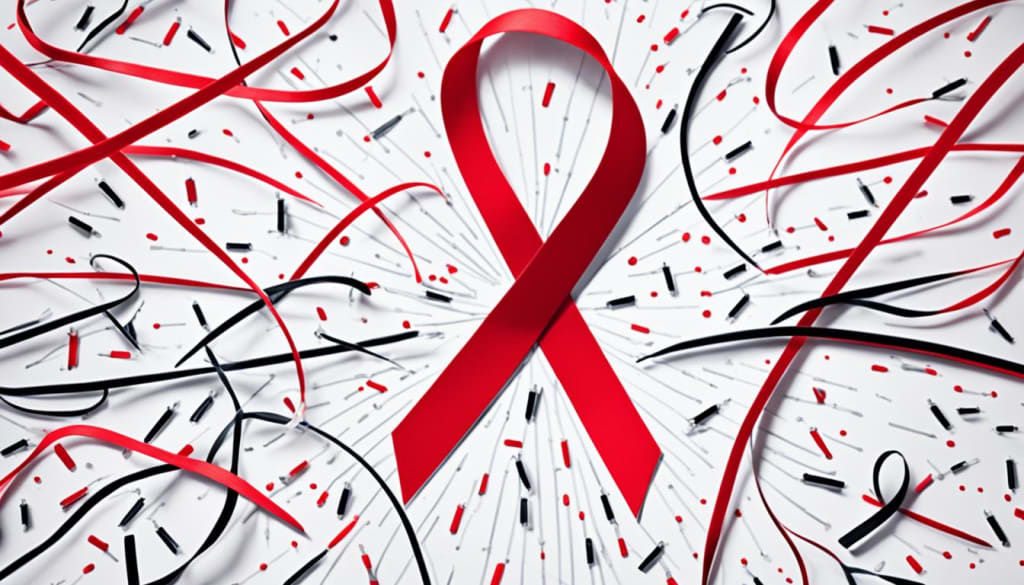HIV AIDS: Symptoms, Causes, Treatment, and Prevention
How To Prevent HIV AIDS

Acquired immunodeficiency syndrome (AIDS) is a chronic illness caused by the human immunodeficiency virus (HIV). HIV weakens the immune system, making the body less able to fight infections and sickness. If HIV is not treated, it can lead to AIDS. Luckily, antiretroviral therapy (ART) is effective. It helps most people with HIV stay healthy and not develop AIDS.
What is HIV AIDS?
HIV is a kind of retrovirus. It weakens the immune system by mainly attacking and killing CD4 cells. These cells are crucial for fighting infections. As the virus grows and kills more cells, it's harder for the body to fight off sickness.
Understanding HIV Infection
HIV is both complex and chronic. If not treated, it leads to AIDS. The virus targets and takes over CD4 cells, which help the immune system. As it destroys these cells, the body's defense system weakens. This makes the person more likely to get sick from rare infections and certain cancers.
The Progression to AIDS
AIDS is the advanced stage of an untreated HIV infection. It shows a very weak immune system. People with AIDS can get very rare sicknesses or cancers. This stage comes after several years, and the time varies.
Impact on the Immune System
HIV damages the body mainly by killing CD4 cells. This weakens the immune system. A weakened immune system makes it tough to fight common and rare infections. These infections or cancers can be life-threatening.
Symptoms of HIV AIDS
HIV and AIDS show different symptoms at each stage. In the early stage, symptoms can be like the flu. They may include fever, headache, muscle aches, and rash.
These signs show up 2-4 weeks after getting infected. They last a few days to weeks. Swollen lymph nodes and a sore throat are also common.
Early Symptoms of HIV Infection
At first, the virus is in large amounts in your blood. But symptoms might be mild. You can have fever, chills, and a rash, feeling tired and have a sore throat.
Chronic HIV Symptoms
With no treatment, HIV can stay for years without showing symptoms. This is the chronic phase. You may not feel bad, but the virus keeps hurting your immune system.
If not treated, HIV often turns into AIDS in 8-10 years.
Opportunistic Infections in AIDS
Advanced AIDS makes the body weak against infections. Common illnesses include Pneumocystis pneumonia and Tuberculosis. Others are Candidiasis, Cytomegalovirus, Cryptococcal meningitis, and Toxoplasmosis.
HIV AIDS: Causes and Transmission
HIV, the human immunodeficiency virus, is mainly spread through direct contact with infected fluids. The most common ways include unprotected sex, sharing drug needles, and coming into contact with infected blood. Also, the virus can pass from a mother to her baby during pregnancy, birth, or breastfeeding.
How HIV Spreads
HIV does not spread by casual contact. This means you can't get it from hugs, handshakes, or sharing food or drinks. It's not in the air or transmitted through water or insect bites. The main ways it spreads are through blood, semen, vaginal fluids, and breast milk when the virus can enter someone else's body.
Risk Factors for HIV
Some behaviors and situations raise the risk of getting HIV. They include having unprotected sex, having many partners, and sharing drug needles. People with other infections or weak immune systems are also at a greater risk.
Using condoms during sex and needle exchange programs greatly decrease the risk of passing HIV on. So, precautions are key in lowering HIV transmission risk.
HIV AIDS: Treatment and Management
There's no cure yet for HIV/AIDS. However, antiretroviral therapy (ART) helps manage the infection. It lowers the viral load to undetectable levels. This supports the immune system to function better.
Antiretroviral Therapy (ART)
The main aim of HIV treatment is to make the viral load undetectable. This is done with antiretroviral therapy (ART). ART uses a mix of HIV drugs. They come from different classes, such as Non-nucleoside reverse transcriptase inhibitors (NNRTIs) and more. It's important to keep the viral load undetectable for a strong immune system and to avoid opportunistic infections.
It's necessary to check viral load and CD4 T cell counts regularly. This shows how HIV treatment is working. While ART is good at handling the infection, it can have side effects. These might include issues like nausea and heart problems. Health conditions related to age should also be considered when treating HIV.
Preventing Opportunistic Infections
Healthcare providers not only work to suppress the HIV virus. They also aim to stop opportunistic infections. This means giving drugs to fight or avoid some infections. They also recommend vaccines and other steps to prevent sickness. Keeping the immune system strong lowers the opportunistic infections risk.
Prevention of HIV AIDS
There is no vaccine to stop HIV, but you can lower the risk. It's key to use effective prevention methods in fighting this lifelong illness.
Safe Sex Practices
Having safe sex is crucial in HIV prevention. Always use condoms during any type of sex to lower HIV risk. Also, make sure to get tested often for HIV and STIs. Knowing your health status helps prevent spreading the virus.
Needle Exchange Programs
Needle exchange programs are important for people who inject drugs. They offer clean needles and syringes, reducing HIV risk. These programs also link you to health services and help with drug use.
Pre-Exposure Prophylaxis (PrEP)
PrEP is great for stopping HIV before it starts. When you take it as told, it can cut your HIV risk by 99%. It's for those who are more likely to be around HIV, like people with many partners or who have unprotected sex.
HIV AIDS and Women
Both men and women see similar signs of HIV and AIDS. But, women with HIV have their own battles. They face higher chances of getting certain infections and health problems.
This includes issues like:
Being more at risk for infections in their reproductive areas
Having a higher chance of passing HIV to their babies
Feeling the impact of HIV on their ability to have children
More women are affected by HIV than men. For example, in 2015, African American women represented over 61% of new infections. This is even though they only make up 14% of the female population in the U.S. Similarly, Hispanic women saw 15% of these new cases.
Injecting drugs also poses a big risk. For instance, in some U.S. cities with a lot of HIV, 72% of women drug users practiced unsafe sex. Additionally, by 2013, only half of female high school students used condoms the last time they had sex. Plus, just one in eight girls had ever checked for HIV.
Younger women and girls face more chances of getting HIV than older women. However, older women may find out about their infection later on. Still, women over 50 also should be careful.
Women face more challenges than men with HIV. Things like cultural issues, being poor, and stigma can make it hard for them to get tested and treated in time.
To help, we have Office on Women's Health's focus for 2024. It’s on stopping HIV and caring for those with it. They want to reach Black women, transgender women, and young people most.
HIV AIDS and Men
Men and women face similar HIV and AIDS symptoms but may deal with different challenges. It's important to know how men experience HIV and AIDS to provide proper care. This helps in getting rid of misinformation and reducing the stigma around the diseases.
Unique Challenges for Men
Men who live with HIV/AIDS have concerns about their sexual health and relationships. The virus can lower their sex drive, cause problems with erections, and affect fertility. This can make them feel bad about themselves. Men often find it hard to talk about their condition because of the stigma. This makes everything tougher for them.
Gay and bisexual men face more challenges, making up the majority of new HIV cases in 2019 in the U.S. They have to deal with how their sexual orientation is seen by society and how it relates to HIV/AIDS. This is a unique struggle for these men.
Men with HIV/AIDS also face a higher risk of other diseases like heart problems, liver problems, and certain cancers. These can make managing the virus harder and affect their life quality.
It takes a comprehensive approach to help men with HIV/AIDS. This includes giving them specific education, access to the right health care, and mental health support. By doing this, we can enhance their health outcomes and life quality. This is crucial for fighting the chronic condition.
HIV AIDS: Complications and Co-Infections
HIV weakens the immune system, making those infected prone to illnesses like opportunistic infections and some cancers. These conditions are called complications and co-infections. They can affect health and well-being greatly in people with HIV/AIDS.
Opportunistic Infections
Having HIV raises the chance of getting opportunistic infections. These include tuberculosis (TB), cryptococcal meningitis, and others. These can be life-threatening if your immune system is weakened.
The World Health Organization notes a much higher TB risk for those with HIV. TB is the top killer of people with HIV worldwide. Yet, a one-month TB preventive treatment for people with HIV proved effective, matching the standard nine-month therapy safety.
HIV-Related Cancers
If you have HIV, you're more likely to get specific cancers. These are Kaposi's sarcoma, non-Hodgkin's lymphoma, and cervical cancer. Thanks to treatment, the cases of these cancers have fallen. Still, they worry those living with HIV.
It's vital to take steps against co-infections if you have HIV. Regular checks, preventive medicines, and timely care can lower the risk of these dangerous infections and cancers. This can boost the health and life quality of those with HIV.
Living with HIV AIDS
Living with HIV/AIDS greatly affects emotions and your body. It's crucial to have support and care. This is important for staying healthy, dealing with the disease, and boosting your life's quality if you're living with HIV.
Emotional and Mental Health Support
Being diagnosed with HIV/AIDS is tough emotionally. It can lead to feelings of depression, anxiety, or even trauma. This is common for those living with HIV. It's key to get help. You can do this by talking to a counselor, joining support groups, or seeing a mental health professional. This helps you cope and feel better.
Nutritional Considerations
Eating right is crucial for those living with HIV. It helps keep you healthy and deal with medication side effects. A diet full of fruits, veggies, whole grains, and lean proteins is best. This strengthens your immune system, eases symptoms, and helps your body heal.
Focus on good nutrition and work with your healthcare team. This way, individuals living with HIV can stay in better health, manage symptoms, and enjoy a better quality of life.
About the Creator
Enjoyed the story? Support the Creator.
Subscribe for free to receive all their stories in your feed. You could also pledge your support or give them a one-off tip, letting them know you appreciate their work.





Comments
There are no comments for this story
Be the first to respond and start the conversation.